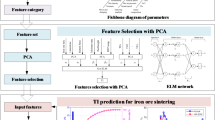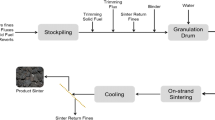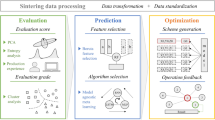Abstract
Optimization of iron ore sintering process is to maximize the productivity and the sinter ore quality while minimizing the energy consumption. However, these economic and technical criteria are sometimes contradictory and the improvement of one criterion generally leads to the deterioration of other criteria. This paper aims to seek the optimal manipulated parameters from the production data by considering this contraction. Several typical groups of manipulated parameters were firstly obtained by clustering the production data, and then one new artificial neural network model—online sequential extreme learning machine (OS-ELM) was established to predict FeO content and tumble strength of sinter ores for each group. Validation results showed that the OS-ELM model established possessed a higher accuracy than conventional BP (back propagation) model. Finally, a multi-criteria evaluation method—VIKOR was applied to obtain a set of compromise optimal solutions. Taking into account both economic and technical criteria, the final solutions acquired are instructive, and the optimal solution can directly reduce fuel consumption by about 0.5 kg per ton sinter ore without degrading sinter ore quality seriously.



Similar content being viewed by others
Explore related subjects
Discover the latest articles, news and stories from top researchers in related subjects.References
Wu M, Chen XX, Cao WH, She JH, Wang CS (2014) An intelligent integrated optimization system for the proportioning of iron ore in a sintering process. J Process Control 24(1):182–202
Oliveira D, Wu SL, Dai YM, Xu J, Chen H (2012) Sintering properties and optimal blending schemes of iron ores. J Iron Steel Res Int 19(6):1–5
Zhou M, Jiang T, Yang ST, Xue XX (2015) Vanadium–titanium magnetite ore blend optimization for sinter strength based on iron ore basic characteristics. Int J Miner Process 142:125–133
Arbeithuber C, Jorgl HP, Raml H (1995) Fuzzy control of an iron ore sintering plant. Control Eng Pract 3(2):1669–1674
Chen G, Chen Y, Liao XF (2007) An extended method for obtaining S-boxes based on 3-dimensional chaotic baker maps. Chaos Solitons Fract 31:571–579
Fan XH, Chen XL, Jiang T, Yuan XL (2006) Optimal control of sintering burn through point. J Huazhong Univ Sci Technol (Nat Sci Ed) 34(11):100–102 (in Chinese)
Yang W, Ryu C, Choi S, Choi E, Ri DW, Huh W (2004) Mathematical model of thermal processes in an iron ore sintering bed. Met Mater Int 10(5):493–500
Ahn H, Choi S, Cho B (2013) Process simulation of iron ore sintering bed with flue gas recirculation. Ironmak Steelmak 40(2):120–128
Pahlevaninezhad M, Emami MD, Panjepour M (2014) The effects of kinetic parameters on combustion characteristics in a sintering bed. Energy 73:160–176
Meng H, Qiao F, Li L (2012) Predictive model of energy consumption in sintering process based on BP neural network. Mech Eng 2:45 (in Chinese)
Feng ZH, Zhang H, Wang YH (2012) Study on prediction and optimization of sintering process energy consumption. Sinter Pelletizing 37(6):13 (in Chinese)
Wang JK, Qiao F, Zhu J, Ni JC (2014) SVR-based predictive models of the energy consumption and performance criteria for sintering. J Tongji Univ (Nat Sci) 42(8):1256–1261 (in Chinese)
Mengjoo E, Liao J, Lin JY (2000) Fuzzy neural networks-based quality prediction system for sintering process. IEEE Trans Fuzzy Syst 8(3):314
Huang GB, Zhu QY, Siew CK (2006) Extreme learning machine: theory and applications. Neurocomputing 70:489–501
Mitra K, Majumder S (2011) Successive approximate model based multi-objective optimization for an industrial straight grate iron ore induration process using evolutionary algorithm. Chem Eng Sci 66(15):3471–3481
Wu SL, Wang QF, Bian ML, Zhu J, Long FY (2011) Influence of iron ore characteristics on FeO formation during sintering. J Iron Steel Res Int 18(5):5–10
Zhang S, Gao WM (2001) Application of neural networks in the prediction of sinter quality. Sinter Pelletizing 26(4):6–10 (in Chinese)
Chen G (2008) A novel heuristic method for obtaining S-boxes. Chaos Solitons Fract 36:1028–1036
Liang NY, Huang GB (2006) A fast and accurate online sequential learning algorithm for feedforward networks. IEEE Trans Neural Netw 17(6):1411–1423
Huang GB, Babri HA (1998) Upper bounds on the number of hidden neurons in feedforward networks with arbitrary bounded nonlinear activation functions. IEEE Trans Neural Netw 9(1):224–229
Opricovic S, Tzeng GH (2004) Compromise solution by MCDM methods: a comparative analysis of VIKOR and TOPSIS. Eur J Oper Res 156:445–455
Acknowledgments
Project (2011BAF18B01) supported by Key Project in the National Science and Technology Pillar Program during the Twelfth Five-year Plan Period; Project (2014) supported by Hunan Platform of Youth Science and Technology Innovation and Entrepreneur.
Author information
Authors and Affiliations
Corresponding author
Rights and permissions
About this article
Cite this article
Li, Zp., Fan, Xh., Chen, G. et al. Optimization of iron ore sintering process based on ELM model and multi-criteria evaluation. Neural Comput & Applic 28, 2247–2253 (2017). https://doi.org/10.1007/s00521-016-2195-x
Received:
Accepted:
Published:
Issue Date:
DOI: https://doi.org/10.1007/s00521-016-2195-x




